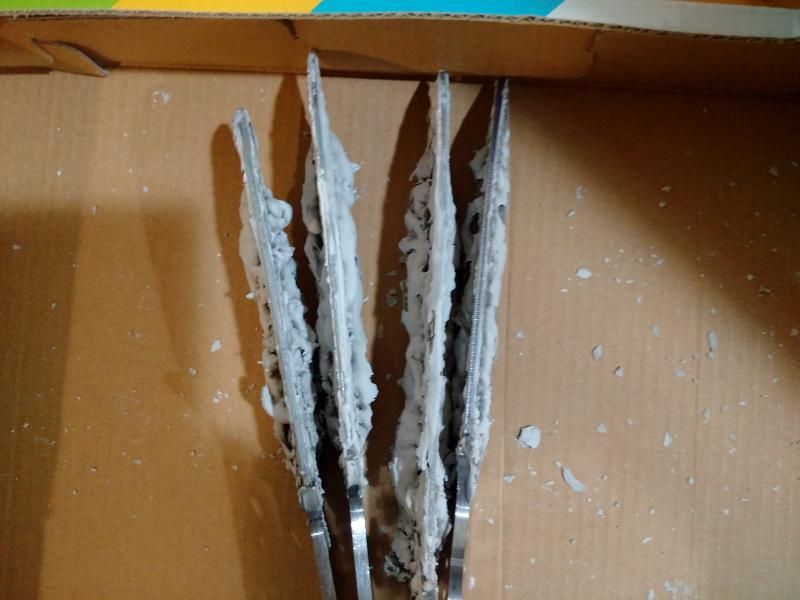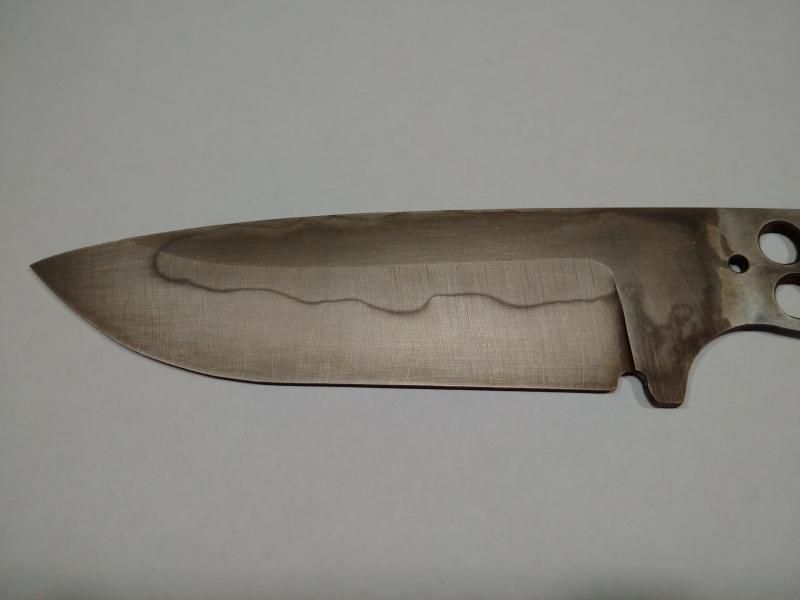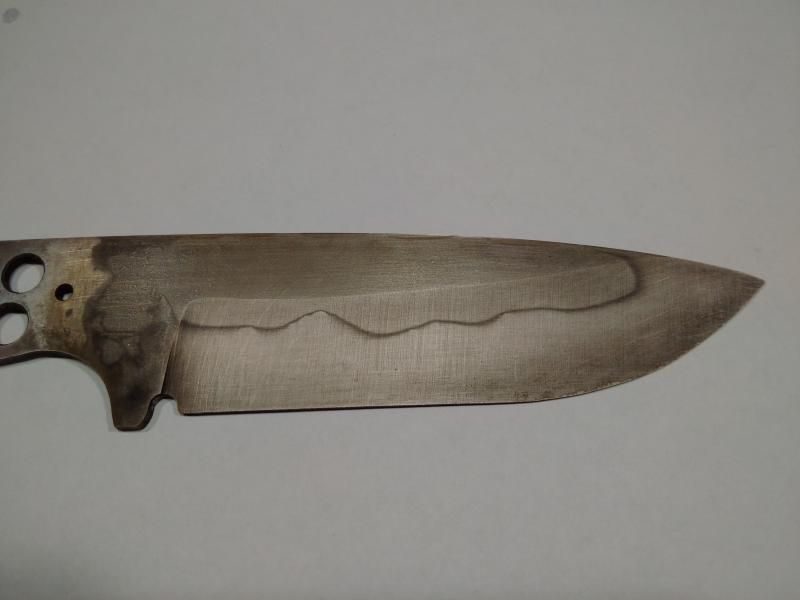You are using an out of date browser. It may not display this or other websites correctly.
You should upgrade or use an alternative browser.
You should upgrade or use an alternative browser.
Brine question
- Thread starter KDX
- Start date
Warren Krywko
Well-Known Member
Keep using it. Its fine.
Doug Lester
Well-Known Member
I would only change it if the salt started to precipitate out.
Doug
Doug
I appreciate the info. Another heat treating related question....if I'm doing 4 knives and the oven temp drops about 100 degrees between the first knife and the fourth one, is is a big mistake? Should the oven be brought back up to temp before the next knife is taken out? The blades were clayed up and the handles were nearest the door. Hopefully I didn't screw up my knives.
Warren Krywko
Well-Known Member
That just doesn't look right. Try a thin layer with the edge clear, or no more than a light wash of thinned clay on the edge. There should be a slightly thicker layer along the bevels, with the edge of the thick part where you want the line to be. 1/8" max is all you need.
Warren Krywko
Well-Known Member
I appreciate the info. Another heat treating related question....if I'm doing 4 knives and the oven temp drops about 100 degrees between the first knife and the fourth one, is is a big mistake? Should the oven be brought back up to temp before the next knife is taken out? The blades were clayed up and the handles were nearest the door. Hopefully I didn't screw up my knives.
I've done four with one heat, but prefer only two now. The 1/2 second to get past the nose starts when the blade drops below 1400f. When Austentizing at 1460f, the oven stays quite close to that temp as I pull one knife out and quench. I found doing more than two, I risked overshooting temp as the elements kicked in to heat the oven after the cooler air entered the chamber when the door opened. If the second or third or n+1 stay between 1460 and 1400, you are fine in the short term. I'm not sure how long, and don't want to mess with it. After two, let the oven equalize, and put the next two in. It prevents problems.
Thanks for the information. I appreciate it. If I were to do two, let the oven equalize and put two more in would I leave them in for only 10 minutes and then quench or would I leave them in longer? The reason I ask is the other knives are brought up to 1460F from room temp so it takes a while for the steel to get there vs just putting in knives at the 1460F temp. I'm not sure if it changes the process or not.
jmforge
Well-Known Member
Yes, just to be sure. A little extra soak isn't going to hurt W2.I appreciate the info. Another heat treating related question....if I'm doing 4 knives and the oven temp drops about 100 degrees between the first knife and the fourth one, is is a big mistake? Should the oven be brought back up to temp before the next knife is taken out? The blades were clayed up and the handles were nearest the door. Hopefully I didn't screw up my knives.
jmforge
Well-Known Member
I use liquid anti-scale and then the clay over that. Remember that if you really start chasing hamons, you may be looking at going as low as 1425F. the general rule that I have been told is that 1/8 thick clay is enough.
Also...is this clay on there too thick?


Warren Krywko
Well-Known Member
Thanks for the information. I appreciate it. If I were to do two, let the oven equalize and put two more in would I leave them in for only 10 minutes and then quench or would I leave them in longer? The reason I ask is the other knives are brought up to 1460F from room temp so it takes a while for the steel to get there vs just putting in knives at the 1460F temp. I'm not sure if it changes the process or not.
I put the first knives in when the oven stabilizes. You risk overheating the tip and edges as the elements overshoot the temp to heat the oven. After the knives are in, I wait until the temp equilizes, then start the soak timing. I just programmed the oven to hold temp for an hour, and I just shut it off when I'm done.
Just a note, you can go lower than 1450/1460, and can increase Hamon potential, but you might not get the correct amount of carbon into solution, giving you a knife that may only have 0.7% carbon in solution. I use 1460, because with my equipment in my shop, that gave me max hardness and consistency. Up or down 10 degrees and consistency dropped off, and 20f resulted in loss of max hardness. The reason you don't want to overheat a hypereuctoid steel is that at higher temps, you will get more than 0.85% carbon into solution, and you will increase the amount of retained austentite after the quench. If you normalize and thermal cycle the steel first, then you have even distribution of alloys, and even, refined grain. At that point, get the euctoid amount of carbon into solution, leaving the rest to form carbides.
Warren Krywko
Well-Known Member
I think that most of use have had to mail order Satanite. Can you get fast oil in Canada?
you can get it from Haughton. It's super expensive to ship though. I got a pail of Maxim DT-48 from canadian knifemaker, but they don't sell it anymore, due to the shipping restrictions.
Warren Krywko
Well-Known Member
Is that clay or furnace cement? Ages ago I bought a tub of furnace cement, thinking it would work, but it got puffy as it dried, and looked similar to this. Needless to say it didn't work, and all I use now is Satanite...
I went to to the yellow pages and looked up refractories. I found an industrial supplier who would sell small quantities. You may luck out. If not, pm me, and maybe the company I used will ship.
I put the first knives in when the oven stabilizes. You risk overheating the tip and edges as the elements overshoot the temp to heat the oven. After the knives are in, I wait until the temp equilizes, then start the soak timing. I just programmed the oven to hold temp for an hour, and I just shut it off when I'm done.
Just a note, you can go lower than 1450/1460, and can increase Hamon potential, but you might not get the correct amount of carbon into solution, giving you a knife that may only have 0.7% carbon in solution. I use 1460, because with my equipment in my shop, that gave me max hardness and consistency. Up or down 10 degrees and consistency dropped off, and 20f resulted in loss of max hardness. The reason you don't want to overheat a hypereuctoid steel is that at higher temps, you will get more than 0.85% carbon into solution, and you will increase the amount of retained austentite after the quench. If you normalize and thermal cycle the steel first, then you have even distribution of alloys, and even, refined grain. At that point, get the euctoid amount of carbon into solution, leaving the rest to form carbides.
Thanks. I will follow the oven directions next time.
Kevin R. Cashen
Super Moderator
Before switching to another refractory I would like to put in a good word for the furnace cement. While Matt’s experience is spot on, and I went through the same issues, this can be dealt with by adjusting your working methods, and in doing so I found the black furnace cement to be much better for me than Satanite. The furnace cement will indeed puff up and form a huge blister like air pocket if heated while still wet, but if you allow it to stiffen, not dry entirely but just stiffen (about 1.5 to 2 hours) this problem goes away. I have even rushed it for demos by setting the blade with the wet cement next to a hot forge. The idea is to evaporate the moisture out gradually instead of boiling it out with immediate intense heat.
Once this was done I found the black furnace cement to be superior to satanite in both adhesion and insulative qualities that I wanted for the most ashi definition. I know many knifemakers swear by the satanite, but I have seen some of the most authentic looking activity done with the furnace cement. My friend Rick Barrett has produced katana’s with fantastic choji (clove blossom) hamon using furnace cement in the way I describe with #50 oil, and that is one tough hamon pattern to nail with anything short of tamahagane, water and a well-trained Japanese hand guiding it all.
Once this was done I found the black furnace cement to be superior to satanite in both adhesion and insulative qualities that I wanted for the most ashi definition. I know many knifemakers swear by the satanite, but I have seen some of the most authentic looking activity done with the furnace cement. My friend Rick Barrett has produced katana’s with fantastic choji (clove blossom) hamon using furnace cement in the way I describe with #50 oil, and that is one tough hamon pattern to nail with anything short of tamahagane, water and a well-trained Japanese hand guiding it all.



